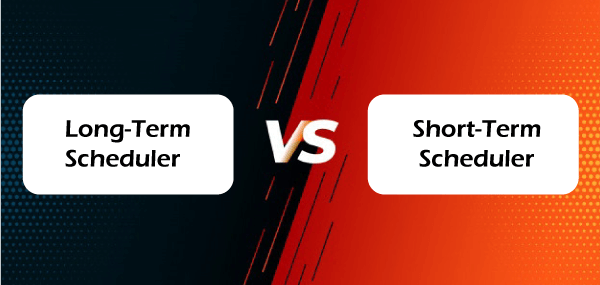Difference between long term Scheduler and short term Scheduler
A process is a program in execution. Modern computer systems use a variety of processes. Scheduling is the process of picking one process from various processes and assigning it to the processor for execution. The scheduler aids in completing this task. Long-term schedulers and short-term schedulers are the two main types of schedulers. Overall, the long-term scheduler maintains a high multiprogramming level, but the short-term scheduler allows the system to run better. In this article, you will learn the difference between a long-term scheduler and a short-term scheduler. But before discussing the differences, you must know about the long-term and short-term scheduler in the operating system.
What is a long-term scheduler?
Long term scheduler is also referred the job scheduler. Various processes are waiting for execution on a computer. These processes are waiting in the job queue. The long-term schedulers choose a job from the job queue or system memory and bring that job to the ready queue to execute in the main memory. Generally, the long-term scheduler chooses a balanced mix of processor-bound and input/output-bound processes from the secondary memory. Moreover, the multiprogramming degree is defined as the maximum number of processes in the ready state. It also helps to manage the multiprogramming degree.
What is a short-term scheduler?
The short-term scheduler is also referred to as a CPU Scheduler. The short-term scheduler’s main job is to choose a process from the Ready Queue that is ready to run and assign the processor to it. In comparison to the long-term scheduler, short-term Scheduler execution is frequent. It has less control over the Multiprogramming Degree. In the Time-Sharing System, the short-term scheduler is the minimum available.
Main differences between the long term scheduler and short term scheduler

Here, you will learn the main differences between the long-term scheduler and the short-term scheduler. Various differences between the long term scheduler and the short term scheduler are as follows:
- A long-term scheduler is an operating system scheduler that chooses processes from the job queue and loads them to execution in the main memory. On the other hand, a short-term scheduler is an operating system scheduler that chooses the process from the several processes that the processor runs.
- The long-term scheduler chooses the processes or jobs from the job pool. In contrast, the short-term scheduler chooses the processes from the ready queue.
- The long-term scheduler controls the multiprogramming degree. In contrast, the short-term scheduler has less control over multiprogramming.
- The long-term scheduler assigns the job to the ready queue for further action by the short-term scheduler, which is referred to as a job scheduler. In contrast, the short-term scheduler assigns the task to the CPU for its process; therefore, it is also called a CPU Scheduler.
- The short-term scheduler chooses processes from the ready queue more frequently than the long-term scheduler chooses processes from the job pool.
- The long-term scheduler is slower than the short-term scheduler.
Head-to-head comparison between the long term scheduler and short term scheduler
Here, you will learn the head-to-head comparison between the long-term and short-term scheduler. Some of the head-to-head comparisons of the long-term and short-term scheduler are as follows:
| Long Term Scheduler | Short Term Scheduler |
|---|---|
| It is an operating system scheduler that chooses processes from the job queue and loads them to execution in the main memory. | It is an operating system scheduler that chooses the process from the several processes that the processor runs. |
| It is also referred to as the Job Scheduler. | It is also referred to as a CPU scheduler. |
| It is slower. | It is faster. |
| It controls the multiprogramming degree. | It provides less control over the multiprogramming degree. |
| It selects the process less frequently. | It selects the process more frequently. |
| It is always present in the Batch OS and can or cannot be present at all in the Time-Sharing OS. | It is present in the Batch OS and is only minimally present in the Time-Sharing OS. |
| It chooses the processes from the job pool. | It chooses the processes from the ready queue. |
| It chooses a good process that is a mix-up of input/output bound and CPU bound. | It chooses a new process for a processor quite frequently. |
Conclusion
For scheduling purposes, both long-term and short-term schedulers are necessary. A long-term scheduler loads processes from memory into the Ready Queue. In contrast, the short-term scheduler assigns CPU to the current process in the Ready Queue.
